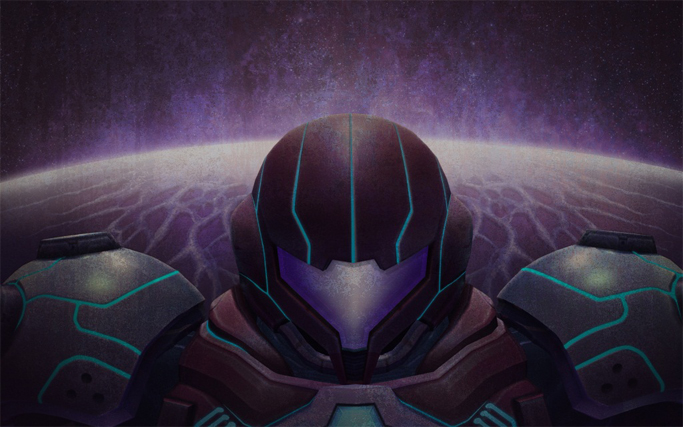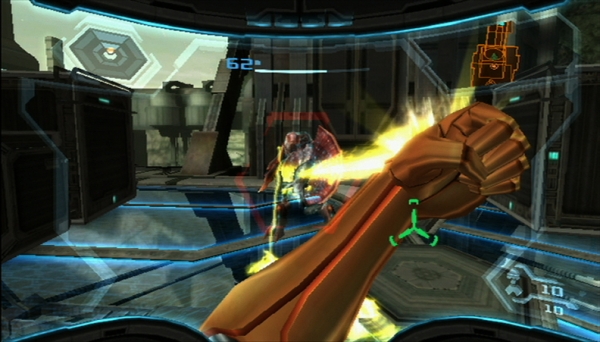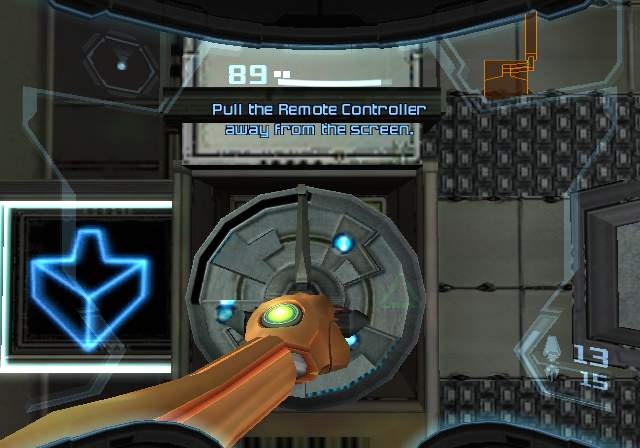
Since it was first unveiled, the Wii Remote has been touted as a revolutionary input device that would particularly benefit first-person console games. There have been, in the years following its release, a number of titles that give credence to this boast, but none perhaps as effectively as Metroid Prime 3: Corruption. While later releases may have improved upon the foundation laid down by Samus’ Wii debut, few can match the game in terms of immersion and interactivity, making the title what is, in essence, the closest example of virtual reality available on the console.
That is, of course, not to say Corruption achieves virtual reality in the way one would normally envision; rather, the title is only described as such because it so effectively uses the Wii Remote and Nunchuk to organically enhance the feeling of immersion one experiences while playing it. Everything about the title, from the HUD that replicates the interior of Samus’ helmet to the simple gesture controls implemented at every step and turn, is designed in such a way that you really feel as though you have assumed the identity of the bounty hunter herself, and it is for this reason that the title remains arguably the best illustration of the Wii Remote’s potential, even nearly four years after its initial release.
While pundits are quick to praise the increased fluidity and precision of aiming as the remote’s most significant contribution to the title, its real innovation is perhaps best illustrated in its application to the Grapple Beam. Although the weapon has long been a staple of Samus’ arsenal, the advent of motion controls has elevated it to new prominence. Thanks to the very nature of Wii’s unique controller, the beam’s functionality has improved dramatically: where it was once exclusively used as a means of traversal, the Grapple Beam in Corruption has been augmented with offensive capabilities as well, placing a greater importance on the item than ever before. This is even evident in the underlying structure of the title: not only is the Grapple Beam acquired much earlier than in either of its two predecessors, but it also receives various upgrades throughout the course of the game. There are even a number of situations specifically tailored to the item: certain enemies, for instance, can only be dispatched using the weapon, and there are numerous puzzles and environmental objects that need to be manipulated by it in order to progress.

All of this improved functionality makes the Grapple Beam much more satisfying to use. Casting the Nunchuk forward to initiate the weapon is fun in its own right, but pulling it back to rip off enemy shields and remove loose panels from walls gives the item a visceral sensation that it is impossible to replicate with a mere button press. Physically enacting the very movements Samus is performing really helps maintain the illusion that you are in her shoes, and it creates a level of immersion precious few other games have successfully achieved.
Beyond this, motion controls are also used when interacting with the game’s environments. These situations are generally more limited than the above-mentioned example, often restricted to specific objects within an area, and while they serve no real purpose other than to illustrate the myriad possible uses of the Wii Remote, they do well in furthering the illusion of virtual reality the game so carefully constructs.
The most frequently-encountered of these instances are the various “gesture locks” included in many of the game’s military facilities. During the adventure, Samus would periodically happen upon certain doors that require physical input on the part of the player to open. The gamer would need to grab onto the handle of the lock, pull the Wii Remote back, twist it as if turning a key, and reinsert it by pushing the controller forward to disengage the door. While the scenario may sound like it would quickly become bothersome, especially given the relative frequency with which similar situations are encountered, the process is a very simple and intuitive one and can be completed in about two seconds. The ease with which these doors are opened prevents these instances from becoming monotonous, and having to physically pull and twist the Wii Remote to accomplish this adds immensely to the sense of immersion one gets while playing.

There are numerous other examples of environmental interactivity interspersed throughout Corruption: the Energy Cells used to power the derelict starship, the G. F. S. Valhalla, are removed from their respective hiding places much in the same way as the aforementioned locks are undone; various levers are pushed and pulled with the appropriate gestures; and even broken wires are soldered together using the Wii Remote’s pointer functionality and Samus’s Plasma Beam. While all of these may seem overtly simple in premise (particularly the last, which amounts to little more than carefully tracing a pattern with the remote), they are each cleverly implemented in the overarching design of the game and simply feel organic. None of the preceding examples come off as a gimmick because each one makes sense within the context of its environment, and being able to physically manipulate your virtual surroundings in these ways really makes you feel like you are a part of the game.
Perhaps most importantly, these gesture commands work because they are so simple: rather than overreach the Wii Remote’s capabilities, Retro Studios kept the motion controls in Corruption to a minimum, using them sparingly and in intuitive ways to draw the gamer into the adventure. Had the developer been more overzealous in its uses of the remote, there would have undoubtedly been many more instances of the game failing to recognize the player’s gestures. This, in turn, would have achieved the opposite of the title’s original intent, quickly pulling the gamer out of the experience rather than in. Thankfully, such pitfalls have largely been avoided through careful planning and clever implementation, and as a result, Corruption stands as a paragon of immersion as well as one of the best examples of how to successfully marry motion controls to a traditional video game experience.




 ShareThis
ShareThis







I loved using the grapple beam in MP3. It was extremely satisfying to rip an enemy’s shied away. As far as the actual aiming goes, I don’t think it is better than the aiming of the GameCube titles. I recently went back and played some Trilogy, and I had a hard time keeping the remote still and aimed at enemies. RE4 got away with it since you couldn’t move the camera with the remote, but I feel that aiming with the wii remote made the game harder, not easier.
I actually felt the same way about aiming when I first played Corruption. I had some difficulty keeping my gun hand steady even when I was just walking around, but eventually it just became easier. I cannot decide if I prefer it over the GameCube control scheme (because I was a really big fan of the latter and had no difficulties whatsoever while playing the first two Primes), but I can see how some would. Still, that’s a topic that has been beaten to death, so I just glossed over it and focused primarily on the Grapple Beam, which can always use more commendation. I think that weapon in particular is the highlight of the game, and it made it much easier for me to overlook what I perceived to be some of the title’s faults. XD
I really think immersion is one of the most crucial and valuable aspects of game design today, yet it’s so often overlooked by critics who get caught up in graphics and gameplay. I won’t care how the game works if I feel a part of that world, will I? Games like Mirror’s Edge and Corruption succeed because they involve and empower the player, they blur the line between self and protagonist.
Admittedly I’ve not played Corruption (gasp) but I did pick up the Prime Trilogy on Wii so I shall no doubt be investing a large chunk of my summer into blasting alien guts across the inside of picturesque, gloomy space stations.
Trilogy was one of the best game bundles ever, and Mirror’s Edge was great too. There are so many good games coming out, it’s tough to plan ahead! But don’t let the MP games get pushed back by 3DS games, Pokemon, Okami-Den etc, though it’s understandable if they do. I used to try and do everything I could in a game, but no more. There are too many games out that I want to play, and by the time I did everything, even more games would be added to the list.
I could not agree more on the importance of immersion in a video game. The first two Metroid Prime titles were very immersive in their own right, but I chose to focus on Corruption specifically because motion controls are integral to the experience and enhance it greatly. There are a number of neat little instances where you have to use the Wii Remote to interact with the environment, and they all just feel natural to perform. They are genuinely clever, too, and I really thought more games would expand upon the ideas that this title pioneered. Even if the actions you are performing aren’t particularly complex, just being able to physically interact with your virtual surroundings does a lot to draw you into the game even more.
I’m just generally terrible at completing games but luckily I don’t buy too many new ones immediately on release. And Pokémon will be at the very top of the list. It won’t even be waiting til summer, I shall be playing it immediately.